To preserve the elasticity of your compression socks, wash them gently with cold water using a mild detergent, and avoid harsh chemicals like bleach or fabric softeners. Opt for hand washing or a delicate cycle, and skip the dryer—air dry instead to prevent heat damage. Wash socks separately from rough fabrics to prevent pilling and stretching. If you want to keep them supportive and long-lasting, pay attention to all these tips and more.
Key Takeaways
- Wash compression socks with cold water using a gentle cycle or hand wash to preserve elasticity.
- Use mild, non-abrasive detergents and avoid bleach or fabric softeners.
- Air dry socks flat or hang in a shaded area, avoiding heat sources like tumble dryers or irons.
- Wash socks separately from rough or abrasive fabrics to prevent pilling and maintain shape.
- Regularly inspect for signs of wear, and replace damaged socks to ensure continued compression support.
Hand Wash or Gentle Cycle
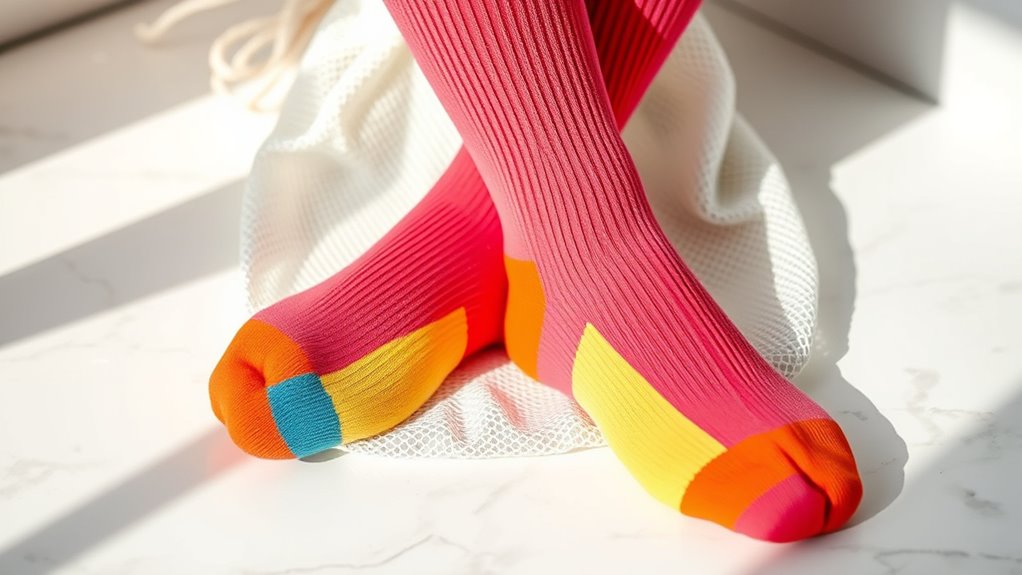
To keep your compression socks in good condition, it’s best to hand wash them or use the gentle cycle on your washing machine. The sock material plays a big role in how you should clean them, with delicate fabrics like nylon or spandex needing extra care. Regular washing is important, but over-washing can reduce elasticity, so you should wash them only when necessary. Using a gentle cycle helps preserve the sock material’s elasticity and prevents stretching or damage. Hand washing is ideal because it’s gentler and reduces the risk of wear and tear. If you do opt for machine washing, always use cold water and a mild detergent. Limiting washing frequency while following these methods keeps your compression socks effective and comfortable longer. Additionally, understanding best restaurants with live music can inspire relaxing environments for recovery and leisure after laundry days. Maintaining proper care not only extends the lifespan of your socks but also ensures they retain their elasticity and support, which is crucial for their effectiveness.
Use Cold Water Only
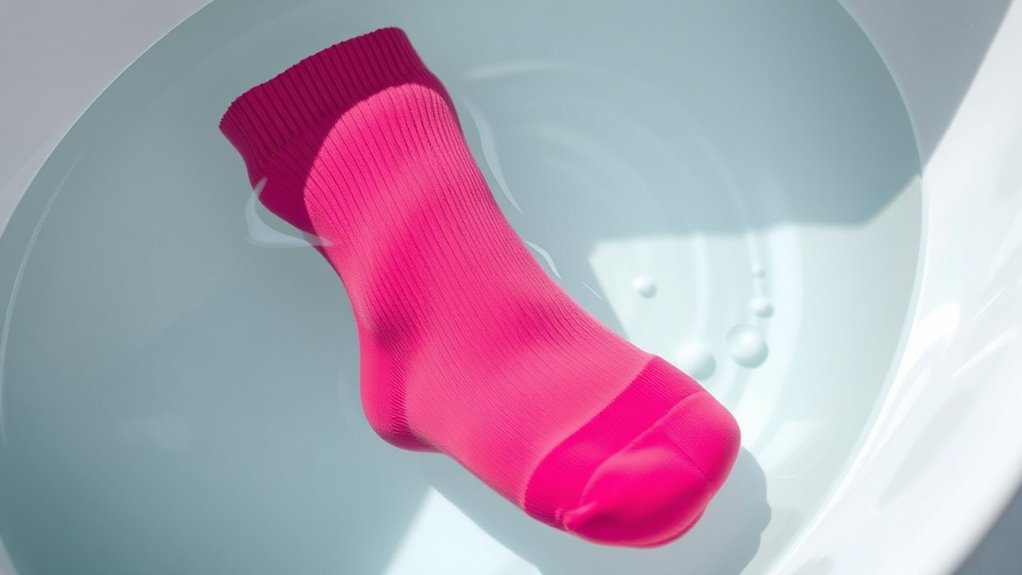
Using cold water is the best way to care for your compression socks after washing. Temperature control is vital to maintain their elasticity and prevent damage. Always opt for cold water to avoid weakening the fibers that give your socks their compression. When selecting a detergent, choose a gentle, mild option that’s designed for delicate fabrics. Harsh detergents can break down the elastic fibers over time, reducing the socks’ effectiveness. Avoid hot water, which can cause the fibers to stretch or shrink, compromising fit and compression levels. By sticking to cold water and a suitable detergent, you help preserve the elasticity and longevity of your compression socks, ensuring they stay supportive and comfortable wear after wear. Incorporating HEPA filters in air purifiers can also help reduce dust and allergens that may affect your respiratory health. Additionally, understanding the importance of fabric care can further extend the life of your compression garments. Proper laundry practices are essential for maintaining their supportive qualities over time.
Avoid Bleach and Fabric Softeners
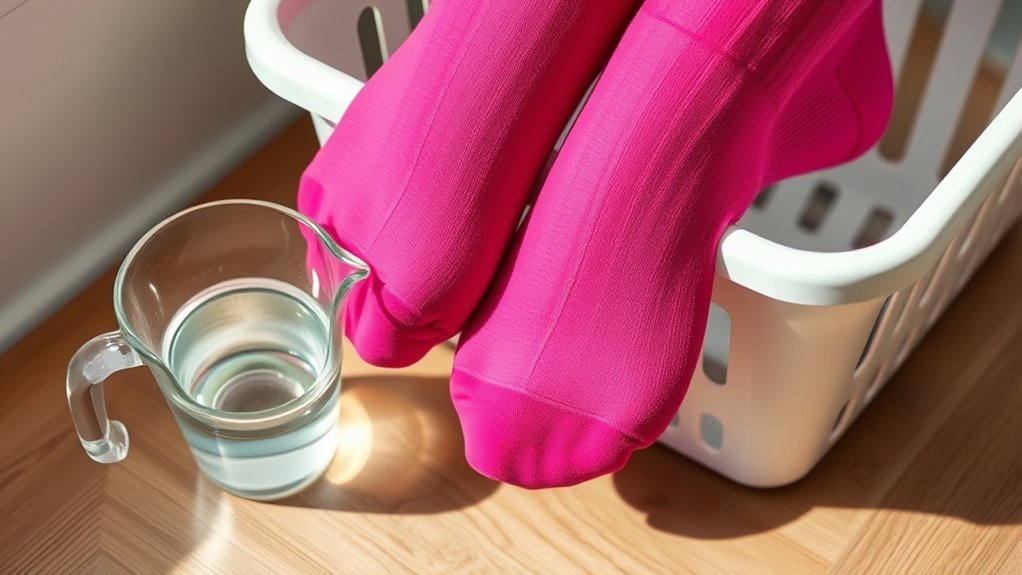
Avoid bleach and fabric softeners because they can considerably damage the delicate fibers in your compression socks. Bleach alternatives like vinegar or baking soda are safer options to clean without harming the fabric’s elasticity. Using bleach can weaken fibers, causing premature wear and reducing compression effectiveness. Fabric softener risks include leaving residues that block the fabric’s breathability and elasticity, making your socks less effective and less comfortable. Instead, opt for gentle detergents specifically designed for delicate fabrics. These help preserve the sock’s elasticity and extend their lifespan. Additionally, proper washing techniques are essential for maintaining optimal compression and comfort over time. Proper care strategies are critical to preventing fiber degradation and ensuring your socks maintain their supportive properties. Remember, harsh chemicals compromise the integrity of your compression gear, so sticking to mild, bleach-free products is essential for maintaining ideal compression and comfort over time. Necessary cookies are also important for ensuring basic site functionalities and a smooth user experience.
Choose Mild Detergents

Choosing mild detergents is essential for maintaining the elasticity and longevity of your compression socks. You want to avoid harsh chemicals that can degrade the fabric’s elasticity over time. When selecting a detergent, focus on gentle options specifically designed for delicate fabrics. Be cautious of fabric softener dangers, as they can leave residues that weaken the fibers and reduce compression effectiveness. Always read labels carefully and opt for detergents free from bleach, dyes, and strong fragrances. Proper detergent selection guarantees your socks stay effective longer and retain their snug fit. Using a mild, non-abrasive detergent supports the preservation of the sock’s elasticity, making them more comfortable and durable with each wash. Additionally, choosing appropriate laundry practices can help prevent damage and extend the life of your compression garments. For example, washing in cold water can further prevent fabric degradation and preserve elasticity.
Air Dry Instead of Tumble Drying
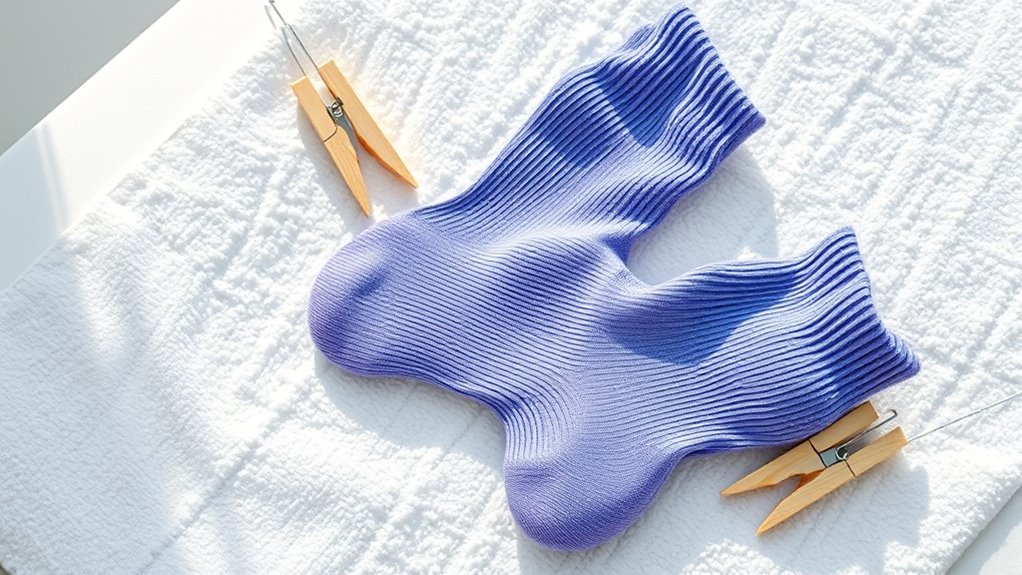
You should air dry your compression socks to keep them in top shape. Gentle air drying prevents heat damage and maintains elasticity. Skip the tumble dryer to extend the life of your socks and make sure they stay effective.
Gentle Air Drying
Ever wondered why air drying is a gentle and effective way to care for compression socks? It helps maintain fabric softness and preserves elasticity, ensuring your socks stay comfortable and effective longer. When you air dry, you’re avoiding the heat that can weaken fibers over time. Hanging your socks in a well-ventilated space allows moisture to evaporate naturally, preventing damage. This method reduces the risk of fabric stiffness and maintains the sock’s original shape. Remember to lay your socks flat or hang them gently by the cuff to avoid stretching. Air drying is simple, eco-friendly, and gentle on your compression socks, helping them retain their supportive qualities for repeated use.
- Use a breathable hanger or flat surface
- Avoid direct sunlight to prevent fading
- Gently reshape socks if needed
- Keep in a well-ventilated area
- Allow sufficient drying time
Avoid Heat Damage
While air drying is gentle on compression socks, using a tumble dryer can cause significant heat damage. High temperatures from tumble drying can weaken elastic fibers, reducing compression effectiveness. To prevent this, always choose drying methods with proper temperature control. Instead of a dryer, opt for air drying in a well-ventilated area. Lay your socks flat or hang them to dry, avoiding direct sunlight or heat sources. This gentle approach preserves the elasticity and longevity of your compression socks. Remember, high heat accelerates fiber breakdown, so resisting the temptation to tumble dry is essential. By carefully selecting your drying method, you ensure your compression socks maintain their fit and compression benefits over time.
Do Not Iron or Use High Heat
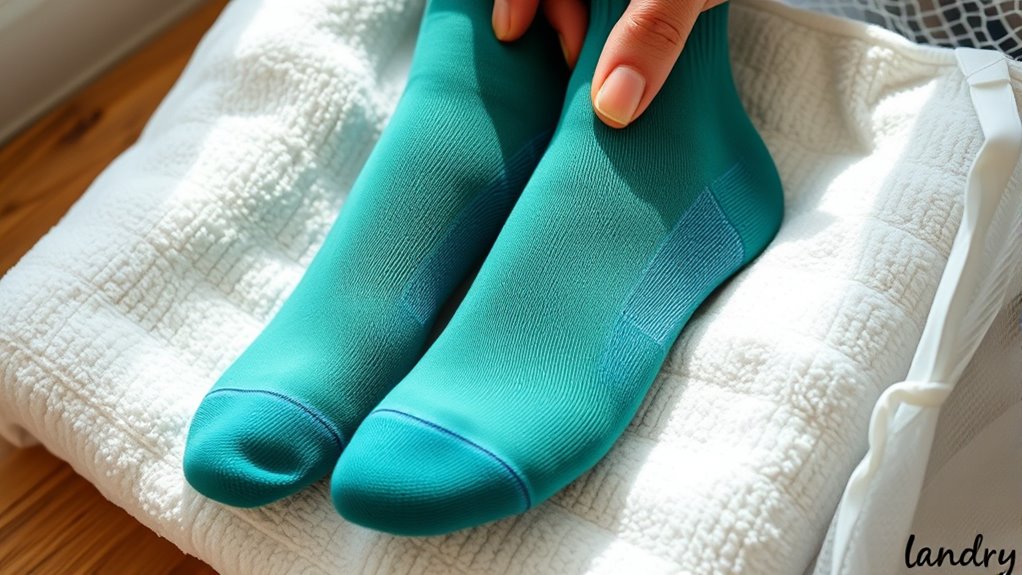
You should never iron your compression socks or expose them to high heat, as it can cause damage. Excessive heat weakens the fibers and reduces their effectiveness. To keep them in top shape, always avoid using hot irons or dryers with high heat settings.
Avoid Ironing Damage
To prevent damaging your compression socks, it’s important to avoid ironing or exposing them to high heat. Ironing risks include heat damage that can weaken the elastic fibers, reducing compression effectiveness. High temperatures can cause the fabric to melt or lose its elasticity, making your socks less supportive. Always skip the iron and stay clear of hot water or dryers that use high heat settings.
To keep your compression socks in top shape, remember:
- Never iron your socks
- Avoid hot water during washing
- Stay away from high-heat drying cycles
- Check care labels for specific temperature instructions
- Handle with care to prevent unnecessary stress
Following these tips helps preserve elasticity and prolongs the life of your compression socks.
Prevent Heat-Related Wear
Exposing your compression socks to high heat can accelerate wear and reduce their effectiveness. Heat damages the elastic fibers, causing them to lose their compression and elasticity faster. To prevent heat-related wear, always air dry your socks instead of using dryers or ironing. High temperatures can also harm moisture control properties, making your socks less capable of wicking away sweat and keeping your skin dry. Additionally, heat exposure diminishes UV protection, reducing the fabric’s ability to shield your skin from harmful rays. Keep your socks in a cool, shaded place after washing, and avoid any direct heat sources. Proper drying and storage preserve their elasticity, moisture control, and UV protection, ensuring your compression socks stay effective longer and provide ideal support.
Wash Separately to Prevent Damage
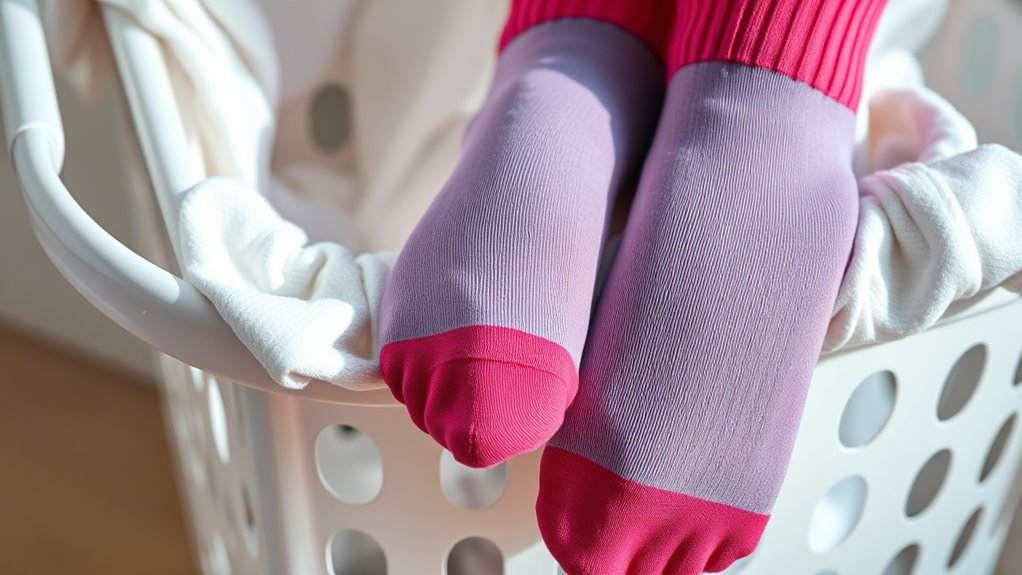
Wondering why it’s important to wash compression socks separately? Washing them alone helps prevent damage that can reduce their elasticity. It also protects the fabric from color fading and pilling, keeping your socks looking new longer. When you mix them with rougher items, you risk snagging delicate fibers or causing pilling that diminishes smoothness. Plus, separate washing minimizes color bleeding, preserving vibrant hues. You’ll also avoid stretching or misshaping the socks, maintaining their compression benefits. To ensure longevity, always wash compression socks on gentle cycles and avoid harsh detergents. Keeping them separate helps your socks retain their supportive shape and bright appearance, so you get the most out of every wear.
Washing compression socks separately preserves their elasticity, vibrant colors, and overall lifespan.
- Prevents fabric pilling and color bleeding
- Maintains elasticity and shape
- Protects delicate fibers from snagging
- Preserves vibrant colors longer
- Extends overall sock lifespan
Regularly Inspect for Wear and Tear
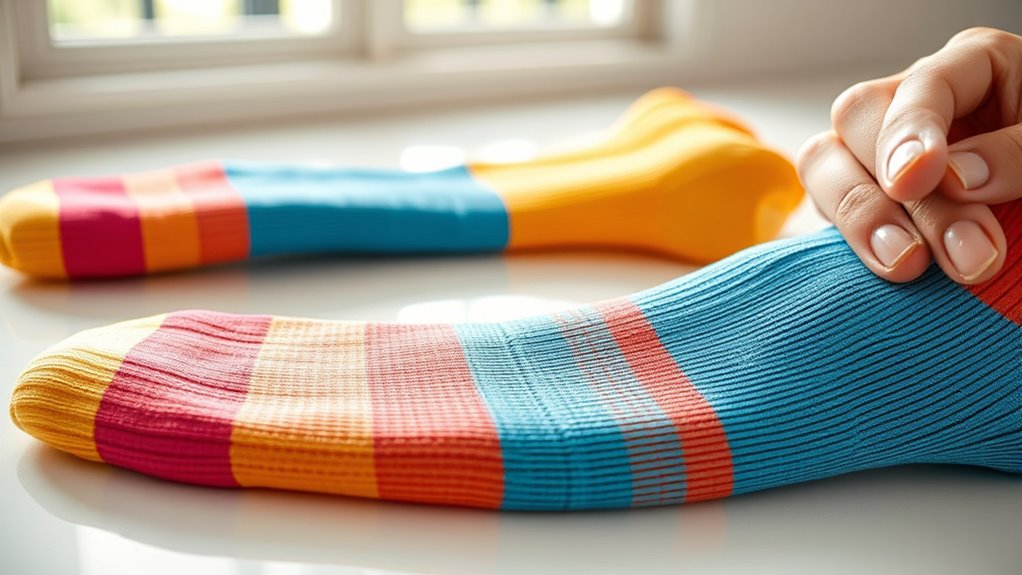
Regularly inspecting your compression socks is essential to guarantee they continue providing ideal support. During your inspection routine, look for signs of wear and tear, such as thinning fabric, holes, or stretched elastic. These issues can reduce compression effectiveness and compromise comfort. Check seams and heel areas closely, as these spots often experience the most stress. If you notice any damage, it’s time to replace your socks to maintain their benefits. Don’t ignore minor fraying or loss of elasticity; early detection helps prevent further deterioration. Incorporate regular inspections into your maintenance routine to prolong the lifespan of your compression socks. Staying attentive ensures your socks remain supportive, effective, and safe for use.
Frequently Asked Questions
How Often Should I Replace My Compression Socks for Optimal Performance?
You should replace your compression socks based on their sock lifespan and replacement frequency. Typically, you’ll want to change them every 3 to 6 months if you wear them regularly, as elastic quality diminishes over time. Keep an eye on signs like loss of compression or fraying. Regular replacement guarantees peak performance, comfort, and longevity, so don’t wait too long to swap out your socks for new ones.
Can I Use Vinegar or Natural Remedies to Clean My Compression Socks?
You might wonder if natural cleaning methods like vinegar benefit your compression socks. Yes, vinegar benefits include gentle cleaning and odor removal. However, avoid soaking your socks in vinegar or using harsh natural remedies that could damage the elastic fibers. Instead, opt for a mild detergent and occasional vinegar rinse to keep your compression socks fresh without compromising their elasticity. Always follow manufacturer care instructions for the best results.
Are There Specific Storage Tips to Maintain Sock Elasticity When Not in Use?
Think of your compression socks as delicate flowers needing the right environment to thrive. For proper storage and elastic preservation, keep them in a cool, dry place away from direct sunlight. Avoid folding or creasing them tightly; instead, gently roll or lay them flat. This prevents unnecessary strain on the fibers, ensuring your socks stay stretchy and supportive whenever you need them. Proper storage keeps your socks fresh and effective longer.
What Signs Indicate My Compression Socks Are No Longer Effective?
You’ll notice your compression socks are no longer effective if they feel loose or don’t provide the same level of compression. Over time, the sock material loses elasticity, especially if you wash them too frequently or don’t follow proper washing instructions. To keep them working well, wash them gently and avoid overdoing it. Replace your socks when they no longer fit snugly or the material appears worn out.
Can Washing Methods Affect the Compression Level Over Time?
Washing methods definitely impact the compression level of your socks over time. If you use harsh laundry detergents or skip proper drying techniques, the elastic fibers can break down, reducing compression. To keep your socks effective, wash them in gentle detergent and avoid high heat during drying. Instead, air dry them flat, which helps preserve the elasticity and extends their lifespan, ensuring they continue to provide the support you need.
Conclusion
To keep your compression socks effective, follow these washing tips diligently. Did you know that proper care can extend their lifespan by up to 50%? By hand washing or using a gentle cycle with cold water, avoiding harsh chemicals, and air drying, you preserve their elasticity and compression benefits. Regularly inspecting for damage also guarantees they stay supportive. Take these simple steps, and your compression socks will serve you longer and perform better every time.









